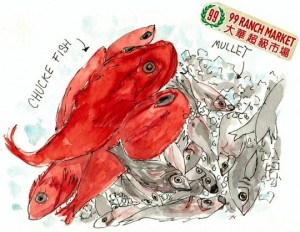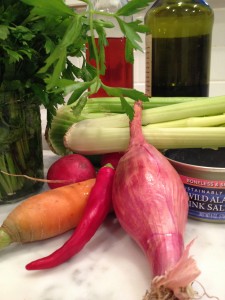A Fishy Issue

Watercolor by Jana Bouc
Eat fish! Don’t Eat Fish! It’s good for you! It’s bad for you! Fish is great, long live fish! There is no more fish, stop eating fish! OH MY WORD, there is a lot of craziness surrounding this issue. People are understandably confused which leads to food anxiety and that’s not good. Let’s go through some of the major issues surrounding this fish problem and see if we can sort out some sensible guidelines:
- An excellent source of protein
- A good source of all those essential Omega-3 fats we need to fight inflammation and disease
- Quick to prepare — another ‘essential’ in this day and age of insta-food
- A versatile protein to cook; it takes kindly to sautéeing, poaching, steaming, braising, baking, roasting, broiling, and grilling.
- Delicious
- We are over-harvesting many of the earth’s populations of fish. With our ingenious mechanized trawlers, we have brought many fish species to the brink of extinction. Seafood Watch, a program of the Monterey Bay Aquarium says “Scientists estimate that we have removed as much as 90 percent of the large predatory fish such as shark, swordfish and cod from the world’s oceans.”
- A solution to this is vast fish farms — at some of them, fish may be fed antibiotics, growth hormones, dyes and other peculiar things like chicken feathers. (See this link to Chef Dan Barber’s TED Talk on looking for a sustainably farmed fish– really, really interesting). Overcrowding in fish farms can lead to disease, and there is concern that disease-ridden farmed fish escape and spread disease to wild populations.
- Fish often carry high levels of mercury, which can build up to toxic levels in humans
- In addition to various contaminants in the water, (think PCB’s etc.) there is concern that fish are increasingly eating teeny nodules of plastic — the broken down bits of our plastic bottles, bags, pens, lighters, containers, and other doo-dahs that float around the oceans and streams looking like food to fish. The small fish eat the plastic, bigger fish eat loads of the small fish and then we eat the big fish; yes we will be eating the plastic.
- Much fish, shellfish in particular, is harvested by humans who live in slave-like conditions. Click here to listen to the NPR story on a fishing boats in South East Asia. There are also reports of wage abuse for fish packers in Louisiana, as you can see if you click on this link.
So, what is a fish eater to do? Well, eat intelligently for a start, and think about using the following 5 help points as guidelines.
- Try to buy and eat fish that is on the Monteray Bay Aquarium Seafood Watch GREEN light list. The Monteray Bay Aquarium provides a fantastic web/app service that follows which fish populations are in trouble and which are more plentiful. It has strict guidelines for sustainable fish farms. This free app is your number-one ally in choosing sustainable fish. Remember, not ALL farmed fish is bad.
- Try to eat a wide variety of fish — and this pertains particularly to those of you pescatarians whose only source of protein is fish. Variety is key, not only for the fish but for you. Don’t just have cod, tuna, salmon and shrimp; try branching out to mackerel, sardines and other small fish.
- Find out where the fish has been harvested. Is it a local catch? Has it been previously frozen? Some turn their noses up at frozen fish, but many believe that when fish is flash frozen on the fishing boat, it reaches you in better condition than fish that has been harvested and then takes a few days to get to market. Learn about your fish. Learn about the labor practices involved in catching and packing it.
- Eat smaller fish. Larger fish tend to have greater quantities of toxins in them, because they have ingested them by eating lots and lots of smaller fish. Smaller fish are generally safer fish.
- Don’t turn your nose up at canned fish. Just make sure it has been sustainably caught and harvested. Yes, sustainably- harvested, canned fish will be more expensive than your bog-standard brand of tinned tuna, but it will be significantly more economical than fresh fish. Just to entice you, I’ll close with a lovely recipe for Crunchy Salmon Salad. Perfect for lunch or a light supper, and even a great way to start the day. Or make it tonight and pack it in your lunch box for tomorrow.
Crunchy and Bright Salad With Canned Salmon
 This is one of those quick-to-throw together things. Don’t be hampered by a lack of specific ingredients. I’ve given you a list at the bottom of the recipe of other vegetables to add or substitute. I originally made this with tons of fresh tarragon from my garden. The garden tarragon is long gone, but happily, I made some tarragon vinegar from it, which brightens this up splendidly. Of course store-bought tarragon vinegar will work as well. Feel free to throw in some fresh chopped basil, chives or even chervil, if you can find it!
This is one of those quick-to-throw together things. Don’t be hampered by a lack of specific ingredients. I’ve given you a list at the bottom of the recipe of other vegetables to add or substitute. I originally made this with tons of fresh tarragon from my garden. The garden tarragon is long gone, but happily, I made some tarragon vinegar from it, which brightens this up splendidly. Of course store-bought tarragon vinegar will work as well. Feel free to throw in some fresh chopped basil, chives or even chervil, if you can find it!
2 tablespoons tarragon vinegar
1 shallot, chopped finely
1 small red chili pepper, minced
3 ribs celery, sliced into small arcs
1 carrot, chopped
1 cup cherry tomatoes (I used yellow), quartered
2-4 radishes, chopped
1 6-ounce can wild, sustainably caught salmon
Handful choopped parsley
3-4 tablespoons extra virgin olive oil
Good sea salt, like Maldon’s.
Pour the vinegar into the bottom of a wide shallow bowl. Add in the shallots, chili pepper, celery, carrot, cherry tomatoes and radishes and toss well. Leave to marinate 10 minutes or so. Add in the salmon with the liquid in the can, crumbling it a bit to break it up and toss gently with the vegetables. Add the parsley and toss well. Drizzle the olive oil over all and season with the good sea salt. This will taste better if you leave the whole thing to marinate for an hour or so. Serve on a bed of young spinach leaves, or perhaps as the stuffing of an avocado. Sometimes I scoop some onto a crisp rye flatbread.
3 to 4 servings.
OTHER ADD-INS. Feel free to add in any of the following as the mood suits you: chopped fennel and fennel fronds, chopped red bell pepper, handful of capers, a tin of white beans, drained and rinsed, good olives, pitted and roughly chopped, and/or some cornichons, chopped.


Comments are closed.